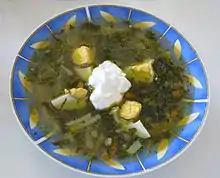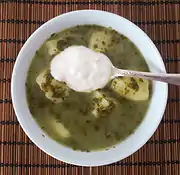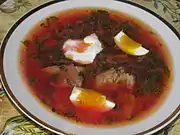Sorrel soup
Sorrel soup is made from water or broth, sorrel leaves, and salt.[1][2][3][4][5] Varieties of the same soup include spinach, garden orache, chard, nettle, and occasionally dandelion, goutweed or ramsons, together with or instead of sorrel.[1][2][3][6][7][8] It is known in Ashkenazi Jewish,[4] Belarusian,[7] Estonian, Hungarian, Latvian,[9] Lithuanian, Romanian, Armenian, Polish,[5] Russian[1][3] and Ukrainian[6][8] cuisines. Its other English names, spelled variously schav, shchav, shav, or shtshav, are borrowed from the Yiddish language,[4] which in turn derives from Slavic languages, like for example Belarusian шчаўе, Russian and Ukrainian щавель, shchavel, Polish szczaw. The soups name comes ultimately from the Proto-Slavic ščаvь for sorrel. Due to its commonness as a soup in Eastern European cuisines, it is often called green borscht, as a cousin of the standard, reddish-purple beetroot borscht.[1][6][7][8] In Russia, where shchi (along with or rather than borscht) has been the staple soup, sorrel soup is also called green shchi.[10][11] In old Russian cookbooks it was called simply green soup.[2][3]
.jpg.webp) Sorrel soup with egg and croutons | |
| Alternative names | Green borscht, green shchi, green soup |
|---|---|
| Type | Soup |
| Region or state | Eastern and Northeastern Europe |
| Serving temperature | Hot or cold |
| Main ingredients | Water or broth, sorrel leaves, and salt |
Sorrel soup usually includes further ingredients such as egg yolks or whole eggs (hard-boiled or scrambled), potatoes, carrots, parsley root, and rice.[1][3][12] A variety of Ukrainian green borscht also includes beetroot.[11] In Polish, Ukrainian, Belarusian, and Russian cuisines, sorrel soup may be prepared using any kind of broth instead of water.[1][3] It is usually garnished with smetana, an Eastern European variety of sour cream.[1][3] It may be served either hot or chilled.
Sorrel soup is characterized by its sour taste due to oxalic acid (called "sorrel acid" in Slavic languages) present in sorrel. The "sorrel-sour" taste may disappear when sour cream is added, as the oxalic acid reacts with calcium and casein. Some may refer to sorrel flavor as "tannic," as with spinach or walnuts.
 Green borscht with egg and sour cream
Green borscht with egg and sour cream Green borscht made with spinach instead of sorrel and with potatoes
Green borscht made with spinach instead of sorrel and with potatoes Ukrainian green borscht including both sorrel and beetroot
Ukrainian green borscht including both sorrel and beetroot
See also
References
- Burlakoff, Nikolai (2013). The World of Russian Borsch: Explorations of Memory, People, History, Cookbooks & Recipes. North Charleston, SC: Createspace Independent Pub. ISBN 978-1484027400.
- Екатерина Авдеева. Ручная книга русской опытной хозяйки. СПб, 1842 [Yekaterina Avdeeva. A Handbook of the Russian experienced housewife. St. Petersburg, 1842]
- Елена Молоховец. Подарок молодым хозяйкам. 1-е издание, 1861, с. 65 [Elena Molokhovets. A Gift to Young Housewives. First Russian edition, 1861, p. 65]
- Marks, Gil (2010). "Schav". Encyclopedia of Jewish Food. Hoboken: John Wiley & Sons. ISBN 978-0-470-39130-3.
- Ochorowicz-Monatowa, Maria (1913). Uniwersalna książka kucharska z ilustracyami i kolorowemi tablicami odznaczona na wystawie hygienicznej w Warszawie w 1910 r. : przeszło 2200 skromnych i wytwornych przepisów gospodarskich i kuchennych z uwzględnieniem niezbędnych warunków odpowiedniej dyety codziennej hygieny oraz kuchni jarskiej (in Polish). Warszawa / Lwów: E. Wende i S-ka.
- Artyukh, Lidiya (1977). Ukrayinska narodna kulinariya (Українська народна кулинарія) [Ukrainian folk cuisine] (in Ukrainian). Kyiv: Naukova dumka. p. 55.
- Chakvin, Igor; Gurko, Alexandra; Kasperovich, Galina (2014). Этнокультурные процессы Восточного Полесья в прошлом и настоящем Этнокультурные процессы Восточного Полесья в прошлом и настоящем [Ethnocultural processes of Eastern Polesie in the past and present] (in Russian). Litres. p. 78. ISBN 9785457646278.
- Guboglo, Mikhail; Simchenko, Yuri (1992). Украинцы: Историко-этнографический очерк традиционной культуры Украинцы: Историко-этнографический очерк традиционной культуры [Ukrainians: A historical ethnographic essay of the traditional culture] (in Russian). Москва: Российская академия наук, Институт этнологии и антропологии им. Н.Н. Миклухо-Маклая. p. 98.
- Ošiņa, Sandra; Ošiņš, Valdis (2014). Traditional and modern Latvian foods and beverages (PDF). The Association of Latvian Rural Tourism.
- Pokhlyobkin, William (2004). Национальные кухни наших народов [National cuisines of our peoples] (PDF) (in Russian). Moscow: Centrpolograf. p. 28. ISBN 5-9524-0718-8. Щи
- Cookery Кулинария (in Russian). Москва: Госторгиздат (Soviet state publishing house for business literature). 1955–58. Retrieved 2 August 2015. Щи, Борщ зелёный украинский
- Sorrel and Pork Soup (Green Borscht) Recipe